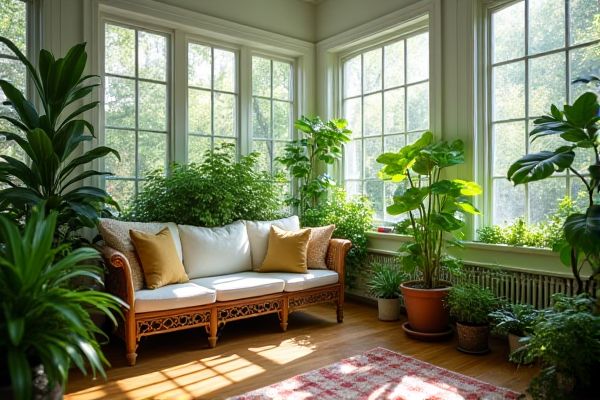
Indoor plants enhance your sunroom with natural beauty, improve air quality, and boost your mood, while artificial plants require less maintenance and stay vibrant without sunlight. Discover which option best suits your lifestyle and space by reading the rest of the article.
Table of Comparison
| Feature | Indoor Plants | Artificial Plants (Sunroom) |
|---|---|---|
| Maintenance | Requires watering, pruning, and occasional repotting | Low maintenance, no watering or pruning needed |
| Air Quality | Improves air quality by filtering toxins and releasing oxygen | No air quality benefits |
| Durability | Can be sensitive to light and humidity changes | Resistant to light exposure, humidity, and temperature fluctuations |
| Cost | Moderate initial cost, ongoing care expenses | Higher initial cost, minimal ongoing expenses |
| Aesthetic | Natural look with seasonal changes and growth | Consistent appearance, no growth or seasonal variation |
| Suitability for Sunroom | Thrives with proper sunlight and humidity control | Ideal for variable light conditions and low humidity settings |
Introduction: Indoor Plants vs Artificial Plants in Sunrooms
Indoor plants in sunrooms offer natural air purification, humidity control, and lifelike greenery that enhances well-being and interior aesthetics. Artificial plants provide maintenance-free decor with consistent shape and color, ideal for low-light conditions or allergy-sensitive environments. Choosing between living greenery and synthetic alternatives depends on factors like sunlight availability, care commitment, and desired ambiance in the sunroom.
Aesthetic Appeal: Real Vs. Faux Greenery
Indoor plants bring a natural vibrancy and authentic texture to your sunroom, enhancing air quality with their organic presence and seasonal growth variations. Artificial plants offer consistent aesthetic appeal without maintenance, providing lasting color and shape that mimics greenery year-round. Choosing between real and faux greenery depends on your preference for natural ambiance versus low upkeep in your indoor environment.
Maintenance Requirements and Ease of Care
Indoor plants in a sunroom require regular watering, occasional fertilizing, and monitoring for pests, making their maintenance more involved but rewarding with natural air purification and aesthetic appeal. Artificial plants demand minimal upkeep, needing only occasional dusting, providing a hassle-free option without the risk of plant neglect or soil mess. Your choice between the two depends on your preference for hands-on care and the natural benefits versus low-maintenance convenience.
Air Quality Benefits: Natural vs Synthetic
Indoor plants in sunrooms significantly improve air quality by absorbing carbon dioxide and releasing oxygen through photosynthesis, while also filtering harmful toxins such as formaldehyde and benzene. Artificial plants, despite their visual appeal, offer no air purification benefits as they do not engage in gas exchange or toxin removal. Choosing natural plants enhances the sunroom environment by promoting healthier, oxygen-rich air and reducing airborne pollutants.
Longevity and Durability in Sunroom Conditions
Indoor plants in sunrooms benefit from natural sunlight, promoting growth and air purification but require consistent care to maintain longevity. Artificial plants withstand sunroom conditions by resisting fading and damage from UV exposure, offering durability without the need for maintenance. Choosing between them depends on balancing the desire for natural air quality and the convenience of long-lasting, low-maintenance decor.
Cost Comparison: Upfront and Long-Term Expenses
Indoor plants in a sunroom typically involve higher upfront costs due to purchasing live plants, quality soil, pots, and potential pest control products, but they offer long-term benefits such as air purification and natural humidity regulation. Artificial plants have a lower initial cost, requiring no maintenance, watering, or replacement expenses, yet they lack the environmental benefits and may need periodic cleaning or eventual replacement due to fading. Over time, indoor plants can become more cost-effective through growth and health benefits, while artificial plants provide budget-friendly decoration without ongoing care expenses.
Environmental Impact: Sustainable Choices
Indoor plants in a sunroom contribute positively to the environment by improving air quality through natural oxygen production and carbon dioxide absorption, supporting sustainable living. Artificial plants, made from non-biodegradable plastics and chemicals, have a higher environmental footprint due to resource-intensive manufacturing and long-term waste accumulation. Choosing real indoor plants promotes biodiversity and reduces reliance on synthetic materials, aligning with eco-friendly and sustainable lifestyle choices.
Allergies and Health Considerations
Indoor plants improve air quality by absorbing toxins and releasing oxygen, which can enhance your overall well-being in a sunroom environment. Artificial plants, while low-maintenance and allergen-free, may accumulate dust that triggers allergies and require regular cleaning to maintain air quality. Choosing live plants can provide health benefits through natural air purification but consider potential pollen or mold allergens if you have sensitivities.
Versatility in Design and Decor Flexibility
Indoor plants offer natural texture, color, and air-purifying benefits that enhance your sunroom's ambiance with authentic greenery. Artificial plants provide unparalleled design versatility and low maintenance, allowing you to customize your space with consistent aesthetics regardless of light conditions. Your choice will depend on whether you prioritize the living vibrancy of real plants or the effortless decor flexibility of artificial options.
Choosing the Right Option for Your Sunroom
Indoor plants in sunrooms enhance air quality and promote natural humidity, thriving best with ample sunlight and regular care, making them an ideal choice for plant enthusiasts seeking health benefits. Artificial plants provide low-maintenance, allergen-free decoration that maintains vibrant color year-round without the need for watering or sunlight, suitable for low-light or busy environments. Evaluating sunroom conditions such as light availability, temperature, and maintenance capacity is essential to determine the optimal balance between real and artificial greenery.
 homyna.com
homyna.com